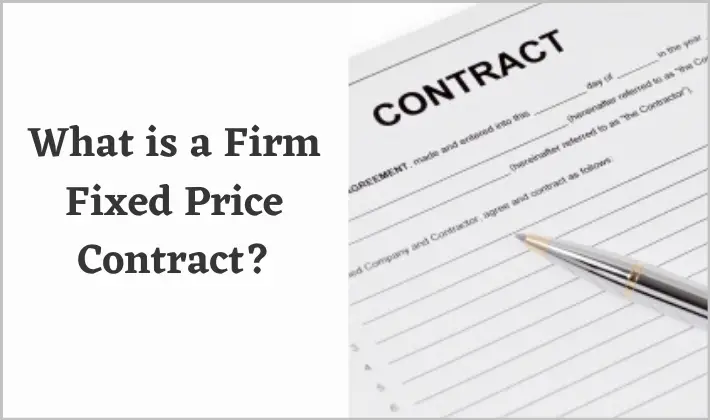There are three different types of contacts in procurement management. These are:
- Fixed Price (FP) – also called as Fixed Fee or Lump Sum
- Time & Material (T&M) – also called as Unit Price or Rate Contract
- Cost Reimbursable (CR) – also called as Cost Plus (CP)
In this article, you will find definition and explanation of the each contract type with the help of a few examples.
The above types of contracts are discussed in the Procurement Management Knowledge Area of the PMBOK Guide (A Guide to Project Management Knowledge). You can expect a few questions from this topic in the PMP Exam (Project Management Professional).
Note: I have discussed different type of contracts from the perspective of project management in this article. However, these contacts types can be used in other business dealings like operations management.
Types of Contracts in Procurement Management (PMP Exam)
A procurement contract is an agreement signed between two entities, when they want to get into a business dealing – one entity wants to purchase goods and/or services from the second entity.
An agreement is a bilateral contract that is legally binding for both the entities. The entity on the buying side is called the Buyer, Customer, or Client and the other entity is called the Seller, Vendor, or Provider.
Note: You can refer to Max Wideman Glossary to read some other standard definitions.
Typically, an agreement document is very detailed and contains many aspects of the procurement like scope, delivery timelines, payment consideration, logistics, quality requirements, change management, contract performance, and legal jurisdiction.
An agreement can be divided into three broad types based upon the scope of procurement and payment consideration.
- Fixed Price – Payment is fixed for a fixed scope of work.
- Time & Material (T&M) – Payment per unit of work is fixed.
- Cost Reimbursable (CR) – Payment varies with the actual cost incurred by the seller.
Although there are three distinct types of contracts, it is not unusual to combine one or more types into a single procurement agreement.
Let’s discuss these procurement contract types in detail.
Fixed Price (FP) Contract
In Fixed Price contract, the buyer pays a fixed amount of money to the seller for the work specified in the agreement. It is also called as Fixed Fee contract and Lump sum contract.
The specified work could be a product, service, set of deliverables or anything else as defined in the agreement document. FP contracts are generally used in construction management, telecom operations, and software development projects.
| Contract Attribute | Buyer’s Responsibility | Seller’s Responsibility |
|---|---|---|
| Scope of Work is well defined. | Buyer has a legal obligation to accept finished work as defined in the Scope. | Seller has a legal obligation to complete work as defined in the Scope. |
| Scope change (modification) is allowed as per the T&C of the contract. | Generally, Buyer has to pay extra (over & above the Fixed Price) for the agreed upon change. | Seller has to complete extra work as defined in the agreed upon change. |
| Price is Fixed. | Buyer has a legal obligation to pay Fixed Price to the Seller after the work has been completed. | Seller can legally claim full payment after completing the work as defined in Scope. |
| Cost Risk is in favor of the Buyer. | Buyer has minimal Cost Risk. | Seller has a Risk of losing money. Conversely the Seller can maximize her/his profits. |
| When is this used? | Buyer can document Scope of Work in detail. | Seller can estimate Cost based on the defined Scope of Work. |
There business contracts have three sub-categories:
- Firm Fixed Price (FFP)
- Fixed Price Incentive Fee (FPIF)
- Fixed Price with Economic Price Adjustments (FP-EPA)
FP contracts are more risky for the sellers. They can run into losses if the total cost is not managed well.
Time & Material (T&M) Contract
In Time & Material Contract, the buyer pays a fixed amount of money (also called as rate) to the Seller for the each unit of work. It is also called as Unit Price contract and Rate contract.
The specified unit of work could be labor duration unit or a material unit as defined in the agreement document – e.g. rate per hour in labor contract and rate per meter in a materials contract.
In T&M, quantity of labor or material is not specified at the beginning. The quantity is billed as per the actual consumption. T&M contracts are generally used in an employment contract for providing skilled/unskilled labor and government contract for delivering standard off-the-shelf consumable products.
| General Attribute | Buyer’s Responsibility | Seller’s Responsibility |
|---|---|---|
| Scope of Work is broadly defined. Quantity is undefined. | Buyer provides acceptance only after work is satisfactorily completed. | Seller has a legal obligation to complete the work as defined by the Buyer. |
| Scope change (modification) is allowed as per the T&C of the contract. | Buyer has a legal obligation to pay for the extra units that were used due to changes. | Seller can legally claim payment for the extra units that were used due to changes. |
| Rate is fixed. | Buyer has a legal obligation to make payment for each unit delivered by the Seller at the predefined rate. | Seller can legally claim payments at predefined rate after delivering the units. |
| Buyer and Seller share the Cost Risk. | Buyer has to pay predefined rate for each delivered unit even if the work is not completed. | Seller can claim only predefined rate for each delivered unit even if the costs escalate. |
| When is this used?/td> | Buyer is unable to estimate the quantity due to uncertainty of requirements or for some other reason. | Seller cannot estimate the total cost due to the absence of well defined Scope of Work. |
T&M is a hybrid of the FP and CR contract types. It resembles FP as there is a fixed rate. It resembles CR as quantity is not specified in the beginning.
Buyer and seller share the cost risk in T&M contracts. Buyer can utilize more quantity than required, whereas seller can overrun their estimated cost target.
Cost Reimbursable (CR) Contract
In Cost Reimbursable contract, the buyer reimburses all allowable cost that were incurred by the seller and pays an additional fee for the work specified in the agreement. It is also called as Cost Reimbursement contract and Cost Plus contract.
The specified work is usually broadly defined in the agreement document. CR contracts are generally used in travel services, government contracting and infrastructure projects where cost of goods change with time.
| Contract Attribute | Buyer’s Responsibility | Seller’s Responsibility |
|---|---|---|
| Scope of Work is either undefined or loosely defined. | Buyer provides acceptance only after work is satisfactorily completed. | Seller has a legal obligation to complete the work as defined by the Buyer. |
| Scope change (modification) is allowed as per the T&C of the contract. | Buyer has a legal obligation to reimburse extra cost and additional fee that arises because of changes. | Seller can legally claim extra cost and additional fee that arises because of changes. |
| Price is not fixed. | Buyer has a legal obligation to reimburse the Actual Cost and agreed upon fee to the Seller. | Seller can legally claim reimbursement of the Actual Cost and agreed upon fee after delivering the best effort. |
| Contract Fee is well defined. | Buyer has a legal obligation to pay the agreed upon Fee to the Seller. | Seller can legally claim Fee after delivering the best effort. |
| Cost Risk is in favor of the Seller. | Buyer has maximum Cost Risk. | Seller has almost no Risk of losing money. |
| When is this used? | Buyer is unable to define Scope of Work due to lack of information or for some other reason. | Seller cannot estimate Cost due to absence of well defined Scope of Work and changing economic conditions. |
There business contracts have four sub-categories:
- Cost Plus Fixed Fee (CPFF)
- Cost Plus Percentage Fee (CPPF)
- Cost Plus Incentive Fee (CPIF)
- Cost Plus Award Fee (CPAF)
CR contracts are more risky for the buyers. They can spend more money than budget if project is not managed well.
Procurement Example for Understanding Contract Types
Let us use a construction contract as an example to understand the different contract types.
Let us assume that we have to do a house renovation project. As part of renovation we need to rewire the whole house. There would be two broad cost components for the rewiring the house:
- Human Resource (HR) Cost i.e. Labor Cost
- Material Cost which includes Wire Cost
Let us also assume that we (Buyer) have called an Electrical Contractor (Seller) to provide us with a Quotation for re-wiring the house.
To prepare the Quotation, the Contractor would start by estimating the cost i.e. the expenses that Contractor is likely to incur. The Contractor would consider aforementioned costs components (HR & Material Costs) to arrive at an estimate.
There could be three different scenarios for arriving at an estimate. These scenarios would depend upon:
- how much information we (as a buyer) have shared with the Electrical Contractor?
- what are the current market (economic) conditions?
The Contractor would choose one of the possible scenarios to arrive at an estimate and give us a quotation based on that. Let us take a look at these these scenarios in detail to understand the three basic contract types.
Scenario I – FP Contract
Let us assume we called a Building Architect before calling the Electrical Contractor. The Architect provided us with complete Electrical Layout & Design. The Architect also gave us Material Specifications of the Wiring to be used.
Essentially, we have finalized everything before the Contractor walked in. We prepared a detailed Statement of Work (SoW) for the Contractor. The contractor would study the detailed Statement of Work (finalized designs and material specifications) to provide a Fixed Price Quotation.
- HR Cost – The contractor would look at the whole house and architectural design to estimate how many Labor units (duration & effort) would be required to complete the work.
- Material Cost – The contractor would survey the house and study the Electrical Layout & Design to make an approximation of how much Wire (quantity of wire) would be required.
Based on above two estimates, the Contractor can estimate Labor and Material Costs. The Contractor would total these Estimates and add some profit to provide us with a Fixed Price Quotation.
This Quotation (once finalized and accepted by us) would become part of the Contract. We will have to pay a Fixed Price to the Contractor for completing the work. Even if the Contractor overruns his estimates, we would not be liable to pay anything extra.
Scenario II – T&M Contract
This scenario would come if detailed Electrical layout & design is not available with us. If that is the case, we will not be able to provide a detailed SoW to the Contractor. In the absence of a Sow, the Contractor will not be able to determine a reasonable estimate of the cost.
- HR Cost – Since the Electrical Layout & Design are not available, the Contractor would not be able to estimate how much Labor units (duration & effort) would be required to complete the work. The Contractor can, however, estimate the Labor Rate per Day (or any other unit of time e.g. hour or week).
- Material Cost – Again the Contractor would not be able to estimate the quantity of wire that would be required to complete the work. The Contractor can, however, estimate the Rate per Meter (or any other unit of quantity e.g. Kg) for different types of wires required.
The contractor would add a suitable margin to estimated Labor & Material Rates for re-wiring the house. The Contractor would provide top-up Rates to us as a Fixed Rate Quotation.
These Rates (once finalized and accepted by us) would become part the Contract. These Rates will remain Fixed for the duration of the Contract. We will have to pay the Rate to the Contractor for completing the work. The actual quantity of Labor and Material consumed (for making final payments) will be determined only after the work is finished.
Scenario III – CR Contract
This scenario is similar to Scenario II above. This scenario would come if Electrical layout & design was not available with us. If that is the case, we will not be able to provide a detailed SoW to the Contractor. In the absence of a Sow, the Contractor will not be able to determine a reasonable estimate of the cost.
In addition, let us assume that Market (Economic) Conditions are constantly changing. There is a constant fluctuation of Labor Rates and Wire Rates in the market. If such conditions persist then the Contractor cannot reasonably estimate Fixed Rates.
In this Scenario, the Contractor would propose (since Labor Rate & wire Rate cannot be fairly estimated) that the Actual Costs incurred by her/him should be Reimbursed. In addition, the Contractor, would ask for a Suitable Fee for the services that she/he would render to complete the work.
This proposal (once finalized and accepted by us) would become part the Contract. Neither the Rates nor the Quantity would be Fixed for the duration of the Contract. Instead, we will have to Reimburse all legitimate Costs and give a (Agreed upon) Suitable Fee to the Contractor.
Final Words
Procurement Management is considered to be a difficult aspect of project management but I think it is an easy topic as purchasing is part of our day to day life. No human being can live without purchasing something or the other.
Which contract type have you seen in your organization? Which type is best suited for your organization and why?
Which type of contact have you used in your projects and in your personal life?
I would love to hear from you.





![Work Package In Project Management [Activity Examples]](https://www.pmbypm.com/wp-content/uploads/2013/12/Work-Package-1.png)



Good Read, to the point which make contract type very clear.
Cheers,
-Sanjay
The real life example made it easy to under stand types of contracts. Good work Praveen
Waseem
well understood quite easy to follow